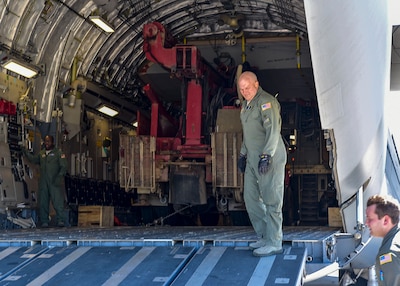By Air Force Maj. Wayne Capps 315th Airlift Wing
PORT-AU-PRINCE, Haiti, Feb. 7, 2018 — Air Force reservists
from the 315th Airlift Wing at Joint Base Charleston, South Carolina, delivered
nearly 100,000 pounds of humanitarian aid to Haiti, Feb. 3-4.
Two C-17 Globemaster III aircraft delivered donated supplies
and a well-drilling truck.
According to the Denton Program office, it is estimated that
more than 8,400 people from the rural areas in Haiti, including an orphanage
and medical clinics, will benefit from the supplies.
“It’s hard to see little kids and families suffering,” said
Air Force Chief Master Sgt. Reggie Godbolt, the loadmaster superintendent for
the 300th Airlift Squadron and one of the loadmasters on the mission to Haiti.
“But as a nation, we give people a hand when they need it. That’s what we are
all about.”
The missions can be challenging as well, he said. “We land
in austere locations, have to manage different kinds of cargo and must deal
with the language barrier,” he explained. “But that’s what we train to do. We
move equipment and supplies wherever it’s needed.”
The relief missions are part of ongoing efforts by the 315th
Airlift Wing to use flight training hours to provide humanitarian relief to
countries in need, while also providing mandated training for C-17 aircrew
members.
‘Best Part of What We Do’
Since October, the 315th Airlift Wing has delivered 72.1
tons of humanitarian aid to Haiti, El Salvador, Guatemala and the Dominican
Republic.
“Missions like these are the best part of what we do,” said
Air Force Maj. Jennifer Phillips, one of the pilots on the mission from the
300th Airlift Squadron. “We don’t think twice about helping people. It’s just
what we do. On these missions we delivered a huge well-drilling truck, food and
medical supplies; and enough equipment to build a library. That’s not something
you get to do every day.”
Missions like these are made possible by the Denton
Amendment, a State Department and U.S. Agency for International Development
program allowing the delivery of donated humanitarian aid to fly on Air Force
assets on a space-available basis.
Kathy Cadden from Operation Ukraine, one of the
organizations that donated some of the aid going to Haiti, said many of the
donated items would have been thrown away.
Buckets and jugs were saved from going to a landfill and can
be used for carrying water, she said, and the donated preschool tables were
older tables being replaced by Woodland Hill Church of Christ in Memphis,
Tennessee. Now these supplies are headed to the Children’s Lifeline School in
Barbancou, Haiti. She also said the many desks, chairs and supplies will go to
schools, hospitals, medical clinics and orphanages in the area.
“I am so thankful to the Denton program and the U.S. Air
Force for making it possible to get food and humanitarian into Haiti,” Cadden
said. “There is a change being made in the area where these supplies are being
sent.”








